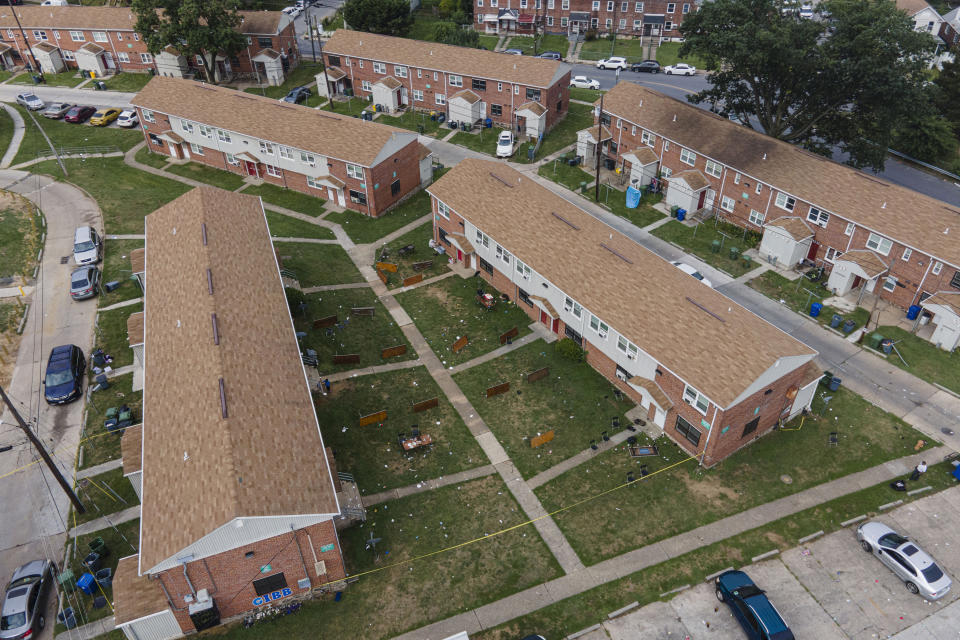Baltimore police showed indifference leading up to July mass shooting, report says
BALTIMORE (AP) — Baltimore police ignored multiple warning signs and failed to take proactive measures in the hours leading up to a mass shooting at a neighborhood block party last month — failures that could indicate officer bias, according to a report examining the city’s response.
Two people died and 28 others were injured when gunshots tore through a large crowd in the courtyard of south Baltimore’s Brooklyn Homes public housing complex as the annual “Brooklyn Day” summertime celebration continued after nightfall. Most victims were teenagers and young adults.
In the years since Freddie Gray died in Baltimore police custody, city leaders have pledged repeatedly to reform the embattled law enforcement agency in hopes of improving community trust, especially among Black residents. Despite those efforts, the report released Wednesday morning shows significant room for improvement.
“Officer indifference may have compromised the awareness, planning and response to Brooklyn Day prior to the large crowds arriving,” department leaders wrote in the report. “Members of the community can view such indifference (whether real or perceived) as a form of bias.”
Acting Police Commissioner Richard Worley promised command-level leadership changes in response to the findings. He said some officers have already been reassigned and the disciplinary process is underway against those deemed responsible.
“We know we made mistakes,” he said during a news conference Wednesday morning. “We will continue to fix what went wrong.”
The report blames police supervisors for repeatedly failing to take action even after Brooklyn Homes residents reported several hundred partygoers being potentially armed and disorderly.
Police also should have known about the event ahead of time and stationed officers there to provide security as they had in years past, but officers were caught off-guard this time around, the report said. That was partly because they failed to properly engage with residents of Brooklyn Homes in the weeks and months prior, according to the report.
The majority-Black community in the southwest corner of Baltimore has long experienced damaging cycles of poverty and neglect. City officials have pledged to pour more resources into the neighborhood, saying the shooting served as a wakeup call.
The report’s findings reinforce earlier criticism from some city leaders who questioned whether police would have responded differently if the shooting occurred in a more affluent area.
“The mass shooting in Brooklyn Homes is one of the most painful chapters in our city’s history,” Mayor Brandon Scott said in a statement responding to the report, which his administration released Wednesday morning.
Scott promised to “address every misstep” uncovered in the 173-page document, which contains sections prepared by several city agencies involved in the shooting response and its aftermath. That includes strengthening notification protocols about large gatherings and increasing security measures in the city’s public housing developments, according to a list of recommended changes.
Violence interrupters with Baltimore’s Safe Streets anti-violence program mediated multiple disputes during the event, including two situations involving people they believed were armed, according to the report. Officials said the mediations at Brooklyn Day fell within the normal scope of duties for Safe Streets workers, who often deal with people carrying guns. But they also said the program will develop a formal notification policy to make city leaders aware of conflicts that could escalate.
Weeks after the shooting, police announced the arrest of a teenager accused of firing gunshots into the crowd before fleeing the scene. Officials said the investigation is ongoing as detectives try to identify other shooters.
While the report examines the roles of multiple agencies, it focuses largely on the police department, which has been under a federal consent decree since 2017 because a U.S. Department of Justice investigation found a pattern of unconstitutional and discriminatory policing practices targeting Black residents.
At a court hearing last week, the federal judge overseeing the agreement said the agency’s response to the Brooklyn shooting could indicate its overall health and progress since the decree was implemented. U.S. District Judge James Bredar said the department has to ramp up efforts to get officers out of their vehicles, walking the streets of Baltimore and connecting with residents. He questioned whether more progress in that area could have led officers to intervene before the shooting occurred.
“No doubt many factors led to this explosion of violence,” he said. “But even before issuance of the report, I am confident that the incident reveals shortcomings in the area of community engagement.”
He said the department should be unsparing in revealing its mistakes and holding responsible parties accountable.
“This is a test,” he said. “The community is watching.”


